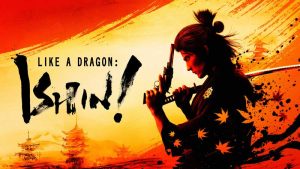Like A Dragon: Ishin
(available for PlayStation 5, PlayStation 4, Xbox One, Xbox Series X/S, Xbox One and PC)
(PlayStation 5 version used for review)
Admittedly I only really got into the Yakuza series a couple of years ago. Like most I started with Yakuza 0 after seeing the overwhelming amount of praise it got, and like everyone else I absolutely loved it. While I still haven’t played all of the Yakuza games, I can still see why it has the fanbase that it does. From the likeable characters to intriguing plots to the jaw dropping amount of side content (and the severe tonal shifts that come with them), it is very easy to see why these games are so beloved by many. Which leads us into Like a Dragon: Ishin, a remake of a PS3/4 game that originally came out in 2014 and was unfortunately Japanese exclusive. At the time, this announcement seemed to have come out of nowhere, but it was also a very welcome one. Not only was this more of this awesome franchise, but now everyone outside of Japan got to experience it. The game came out on the 21st February 2023 for PS4/5, Xbox One/Series X and Windows.
In Like a Dragon: Ishin you play as Sakamoto Ryoma, a samurai of the Joshi rank returning to his home of Tosa. He reunites with his sworn brother Takechi Hanpeita and his adoptive father Yoshida Toyo who’s created a faction called the Tosa Loyalist Party, with the goal of ending the social class system of Tosa, and asks Ryoma to join. However while discussing negotiation plans, a masked assassin sneaks into the room and murders Toyo. Ryoma gives chase but the assassin gets away, and he gets accused of murdering his adoptive father. He then flees from Tosa, vowing not to return until he has discovered the identity of the mask assassin and proves his innocence. A year passes and Ryoma has taken up residence in Kyo and now uses the alias Saito Hajime, with still little knowledge of who killed his father. The story of this game is great, doing a good job emulating the journey of the real life Sakamoto Ryoma while taking some very heavy liberties to help aid the story. It also captures the time period, both in setting and worldbuilding, perfectly, it really did feel like I was wandering through Japan during the Edo Period.
First of all, compared to the original Yakuza Ishin, this game has been greatly improved with how it looks. Both lighting and colouring makes a near night and day difference, not to mention the improvements to the quality of graphics and frame rate. Though, when comparing it to more recent Yakuza games, there isn’t really any improvement. Not that that’s a complaint, Yakuza games already look really good, so this game being on the same level as those ones is perfectly fine in my book. Some character models have been changed as well, as characters in both versions of Ishin look identical to characters from the other Yakuza games (Sakamoto Ryoma looking like Kiryu Kazuma or Okita Soji resembling Goro Majima as an example), however this game decided to do a bit of tweaking with some of the other characters, so now we have characters that look identical to ones in Yakuza 0, 6 and Like a Dragon. Voice acting as always is very good, with the cast from the previous games returning to reprise their roles and they kill as always. Finally there’s the music, the music only really shows up during cutscenes, minigames or battles, and not while just traversing the streets of Kyo, but I can say that the songs are very well done, not only bringing the flare and energy from the previous games, but some even add in wood instruments to match to the time period and it works really well.
Like a Dragon: Ishin plays the exact same as most other Yakuza games, it is a Beat ’em up that takes place in a small sandbox, and has a heavy focus on story and side content. While combat works the same way as any other Yakuza game does, it makes a few changes that really makes it unique. Some battles will be scripted, whether it’s a part of the story or during a substory, though most of your fights will be from random encounters that you run into while moving from place to place – believe me, an alarming number of people want to fight you. In combat you’ll have access to four different Styles: Swordsman, Gunman, Brawler and Wild Dancer. As you can guess from their names, these combats essentially just swap around what weapons you wield, but each one is vastly different, and each has their own benefits and caveats. For example, Brawler lets you grab enemies and perform different throws as well as let you use random objects as weapons, though damage doesn’t really increase as much as the others, or Wild Dancer being very good for attacking multiple opponents at once with the disadvantage of you being unable to block. If you’re at all like me, you’ll likely find yourself swapping from one Style to another to get a better advantage against certain opponents, or just to spice combat up a bit. Personally, I found myself using Swordsman and Wild Dancer the most, as I enjoyed sword combat the best and felt it had the best upgrades.
As to be expected, one of Yakuza’s most iconic mechanics, the Heat System, returns for this game. As you attack your opponents, you’ll notice a metre next to your health increase with every hit. Once filled up at least once you’re able to perform a Heat Attack that will deal a lot of damage or just outright kill an enemy. Though you can’t just perform this the moment the bar is filled, there are one or two extra steps to fulfil before you can. Whether or not you can do a Heat Attack will depend on other factors, such as if the enemy’s been knocked to the ground, what fighting Style you’re using, what the environment is like when you’re fighting etc. The Heat Gauge increases quickly so it stops you from exploiting it, and seeing as it’s really difficult to knock some enemies and bosses onto the ground, it makes them feel more like a challenge than fighting normal enemies does.
When it comes to enemies, you’ll find that there is little variety. You’ll be exclusively fighting samurai or bandits that use a multitude of weapons, from swords to spears to guns, some will even fight you bare-handed. As said though, you won’t find these enemies using that many different Styles and they’ll mostly fight the same. Honestly the most variety you’ll have in the fights is that there’ll be more opponents. While this isn’t the worst and doesn’t really detract from fights all that much, it can lead to fights getting stagnant and tiresome after a while, especially when seeing how big this game is.
At the end of every battle, you’ll be ranked on Attack, Defence and Style. It sounds like a simple ranking system, though unfortunately it’s anything but and doesn’t make sense half the time. There are plenty of times where I will fight near perfectly, not taking a single hit and being super aggressive, but will get an incredibly poor rating, and there have been numerous occasions where I get absolutely battered and play really poorly, and yet I’ll get an A rank in every category. What makes it worse is that your grades actually really matter in the game, the higher the grade you get the more experience you receive, so the fact that this system makes no sense is even worse.
There are a few things that you can do to make combat a bit easier. For starters, like in every other Yakuza game, you have a skill tree to unlock more abilities. Every Yakuza game that I’ve played has had different ways for you to unlock skills (using money in Yakuza 0, or gaining specific stats in Kiwami 2), luckily this game seems to have it very simple. Obtaining these skills requires you to use one of two types of orbs, Training Orbs and Soul Orbs. Training Orbs are by far the easiest to unlock as you’ll obtain these by just playing through the game and levelling up, and unlike Soul Orbs they can be swapped out and given to other skills. Soul Orbs on the other hand are a bit more difficult to unlock, unlike Training Orbs, they can only be used to unlock a skill for the Style that shares its colour (blue for Swordsman or yellow for Gunman), and to unlock them you’ll have to fight with that Fighting Style and rank up with it, the more you use a certain Style the more Soul Orbs you’ll get. There are some skills that are locked from the start of the game and that you will not just be able to unlock with the Orbs. To unlock these you’ll have to visit one of the Dojo’s spread throughout Kyo and take part in a special training event, once complete you’ll have unlocked the slot, though you’ll still need an Orb to be able to use the skill.
While equipment has been around in other Yakuza games, it would obviously have more importance in this one. Throughout the game you’ll unlock a variety of swords and guns, some of which you’ll unlock as you progress through the story while others you’ll have to obtain from the Blacksmith. Yes there is a crafting system to unlock and upgrade most of your equipment, but I don’t actually mind it in this game. It reminds me a lot of the crafting system of the Monster Hunter franchise where, by using materials you’ve obtained from fights, each weapon upgrades into another and there are branching paths so you’ll have to get and craft multiple of the same weapon in order to be able to unlock all of them. On top of just using the Blacksmith to create more weapons, you can also use them to equip seals onto weapons. These will add different effects to your weapons such as an increase to damage or how much EXP you get in battle. Some weapons will come with Seals already equipped, though you’ll have to obtain more to fill up those empty slots.
A mechanic added to this game – that wasn’t even present in its original version – are the Trooper Cards. The Trooper System is a mechanic that adds different and incredibly useful abilities to aid you in combat. There are five different types of Troopers Cards: Offensive, Defensive, Medical, Support and Assist, and these abilities will consist of an AoE attack that will deal a severe amount of damage, heal a small amount of health over time or a big chunk of health all at once, or even just a buff to a specific Fighting Style. Even bosses will now have new attacks that act like they’re using a Trooper Card. There are a few ways to unlock Trooper Cards, by either spending money to enlist them, by fighting them in random encounters and then offering their service afterwards, or by completing Battle Dungeons (which we’ll get into later). I do like this mechanic, I feel like it adds a level of strategy that was missing from the other Yakuza games. My one issue with it is that it does make the game significantly easier, you don’t feel nearly as threatened against a large group of enemies when you can easily destroy them with a single AoE attack. It’s not a major gripe, but it’s still very noticeable.
As you’d expect from a Yakuza game, Like a Dragon: Ishin has a lot of side content… Like, a lot of side content… Like, so much that you likely wouldn’t be able to experience it all without a guide, levels of side content. In other words, way too much for me to go into detail with, so instead I’ll just try and summarise it all up as quickly as I can (though, knowing me that’ll be like asking a dog to please leave the sausage that just dropped on the floor alone). Returning from other Yakuza games are Substories, that will have you interacting with individuals or scenarios, that range from serious to weird to just downright wacky, and will have you perform a certain task to complete it, ranging from having to fight an onslaught of enemies to help an innocent woman, to just giving the drunk man another bottle of sake. Doing so will reward you with some Virtue and maybe something a little extra. Some of these Substories will also increase your relationship with that individual, which will lead to further development into that story or just net you a reward. Also returning from the previous games are fan favourite minigames, like the rhythmic wonders of Karaoke and Dancing, where you’ll find some of the best songs you’ve ever heard, as well as not so beloved ones like Gambling (I just can’t deal with these after what I went through in Kiwami). Also returning is the Fighting Arena, where you can fight in a variety of tournaments against a gauntlet of opponents. Each of these opponents will fight very differently from the people you’re fighting on the streets, which means a lot of diversity in the fights as well as a lot of frustrations against the tougher lot.
A new addition to this game is the Battle Dungeons. Because of story reasons, you’ll eventually gain access to these dungeons, where you must run through them and complete a task in each one, whether it involves you just annihilating all enemies that stand in your way, or collecting three of a certain item, all ending with a boss at the end. Beating these will net you a hefty amount of money as well as a new Troop Card. I really like this part of the game, I will admit that the game did get fairly easy after a certain point and these dungeons are quite the challenge. I found myself going through one or two of these every time I played just because they were that much fun.
Another addition to this game and honestly one of my favourites is the Second Home. You’ll gain access to the Second Home part way through the game and the main mechanic here is farming. You’ll get a small plot of land, that can be expanded later on, and using it you can grow different vegetables. Each type of vegetable will take up a certain amount of space so you’ll have to be conservative with what you put on and really plan out what you’re planting. When the food has grown and has been harvested, you can do one of two things with them, you can either sell them – which is essentially the easiest way to get rich in this game – or you can use them to cook meals, which is done via another minigame. If you cook meals you can use them as a way to heal yourself, in fact you’ll find them more effective than the medicine you can buy while in Kyo, thus giving you more of an incentive to cook more meals. I genuinely love farming in this game, it’s just a nice change from the barrage of battles you have to go through. That being said though, while I do like the cooking minigame it can get tedious when you’re trying to make multiple of the same dish as you can only make one at a time and have to go through all the menus all over again.
Through doing pretty much anything in the game, you unlock Virtue. Virtue basically acts like Completion Points in the previous games, where you can use them at a shrine to unlock upgrades like enhanced sprinting or a larger inventory. Eventually you can even exchange Virtue at a shop for even better items. I cannot stress how useful Virtue is, as some of these upgrades are incredibly useful, from both helping you while playing the game or even just acting as small quality of life improvements.
It’s honestly a shame that we had to wait nine years to finally give this game a go, because I can happily say that Like a Dragon: Ishin is a damn good game. It has a number of additions that really enhance it and brings very few gripes with them. If you’re a Yakuza fan, then you absolutely should play this, and even if you’re not, there are worse games to introduce you to this masterpiece of a series.
9.3/10
Anime Amigo and Nerd Consultant
Share This Post:








Leave a Reply